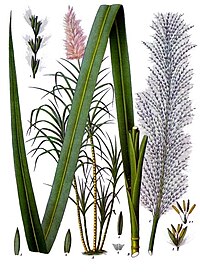
Photo from wikipedia
Simple Summary Human food needs have driven the formulation of scientifically derived artificial diets for large scale sustainable production of fish, birds and animals. The carcass milling technique (CMT) has… Click to show full abstract
Simple Summary Human food needs have driven the formulation of scientifically derived artificial diets for large scale sustainable production of fish, birds and animals. The carcass milling technique (CMT) has been instrumental in its achievement. It formulates specific diets from nutrient analyses of the species to be mass-reared, and their natural host foods. These diets do not deleteriously impact growth or development, sometimes enhancing this. In recent times, the CMT is being used to formulate artificial insect diets to provide high quality individuals needed to feed other organisms, and treat large areas of agricultural land containing crops and animals in sustainable area wide-integrated pest management (IPM) programmes. CMT was used to formulate four diets to mass produce Eldana saccharina needed for a sterile insect program, in a cost-effective nutritious way without compromising fitness. Yields in terms of pupae obtained from the larvae inoculated were high for all diets (97% at day 27), as was female fecundity and fertility (>870 eggs per female; >90% fertile). Quickest larval development time (17% pupae at day 20), highest adult emergence (98%), and females mated with most males (mean = 3) occurred from the individuals reared on the minimum specifications (MS) CMT diet, making it the preferred choice to replace the routinely used diet. Abstract The carcass milling technique (CMT) formulates specific diets from nutrient analyses of species to be reared and their natural host plants. The first of four diets developed used the minimum ingredient specifications (MS) of published diets for Eldana saccharina. The remaining were based on the ideal amino acid composition and profile (IAAP) of its second (IAAP2), third/fourth (IAAP3/4) and fifth/sixth (IAAP5/6) instar larvae. The control was a modified Ostrinia nubilalis diet. Survival to pupae of inoculated E saccharina neonates was high on all CMT formulations (>92% at day 20 and >97% at day 27). Larvae developed fastest on the IAAP3/4 and MS diets (25% and 17% prepupae and pupae on day 20, respectively). Pupal weights were not significantly influenced by CMT diets (0.1121 g male; 0.1864 g female). The control group produced heavier male and female pupae (0.1204 g; 0.2085 g, respectively). Adult emergence was highest from the MS (98%), then the IAAP3/4 (97%) and control (96%) diets. Sex ratio of adults from all diets was close to one. Males from the IAAP5/6 diet mated with significantly more females (six), and females from the MS diet mated with more males (three) than those from remaining formulations. All females produced in excess of 870 eggs, more than 90% were fertile after mating. The pH (4.79); moisture content (81.43%) and water activity (0.92 aw) of the diets were not significantly different, maintaining quality and stability throughout the larval period, ensuring optimal growth and development. The MS diet formulation was the preferred choice to replace the current E. saccharina diet.
Journal Title: Insects
Year Published: 2022
Link to full text (if available)
Share on Social Media: Sign Up to like & get
recommendations!